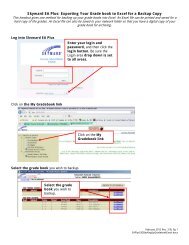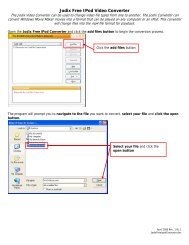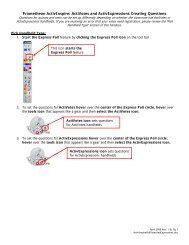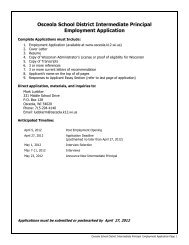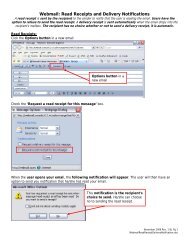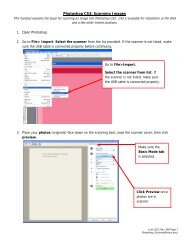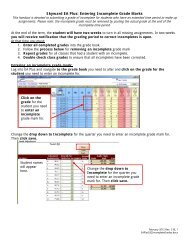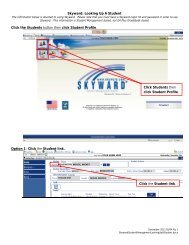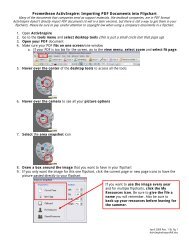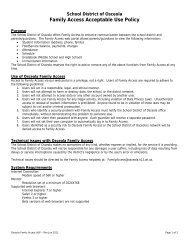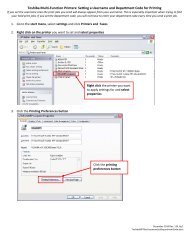Windows Movie Maker: Capturing Video Using a Video Conversion ...
Windows Movie Maker: Capturing Video Using a Video Conversion ...
Windows Movie Maker: Capturing Video Using a Video Conversion ...
Create successful ePaper yourself
Turn your PDF publications into a flip-book with our unique Google optimized e-Paper software.
<strong>Windows</strong> <strong>Movie</strong> <strong>Maker</strong>: <strong>Capturing</strong> <strong>Video</strong> <strong>Using</strong> a <strong>Video</strong> <strong>Conversion</strong> Device for<br />
VHS Tapes, DVD <strong>Video</strong>s or Analog Camcorders<br />
Importing is not an option for some video formats as there is not a file to import. Therefore, a video conversion device<br />
must be used to capture the video in order to create a file for a person to work with. Capture devices can be checked out<br />
from the technology department via the help desk. Please put a request in the help desk for a capture device and<br />
also please put in the name of the computer you desire the capture device installed on. Please note that the capture<br />
device will be installed on one computer of your choice. Please also provide the time frame you will need the capture<br />
device for so it may be reserved for the entirety of your use.<br />
Attach the capture device by hooking up the colored AV cables to the matching color slot on the<br />
VHS/DVD player or the analog camcorder. Then attach the other end of the colored AV cables to<br />
the matching color slots on the capture device. Hook the USB cable to the computer and open<br />
<strong>Windows</strong> <strong>Movie</strong> <strong>Maker</strong>. Please note that a member of the technology department must install the driver for<br />
the capture device before you can utilize it. Once in <strong>Movie</strong> <strong>Maker</strong> click the capture from a video device<br />
link. If you cannot see the capture from video device link, click the drop down arrow next to the<br />
capture video menu to expand the selections.<br />
Select the capture device you have connected and change the audio device to USB2.0, using the<br />
dropdown arrow, and change the input source to composite, using the dropdown arrow. Then click the<br />
next button.<br />
April 2009 Rev. 2 BL 1<br />
<strong>Windows</strong><strong>Movie</strong><strong>Maker</strong>CaptureDevice.doc
Enter an appropriate title for the captured video segment and save the file to an appropriate location.<br />
To change the saving location click the browse button and navigate to the location the file should<br />
be saved to. It is recommended to save the file to a C: drive location, like the desktop, and then copy it to a<br />
network location once the capture is completed. Once you have named the captured segment and have<br />
chosen a save location, click the next button.<br />
It is recommended to set the radio button to best quality unless you are using the end project for web<br />
integration or something similar. Contact the Help Desk if you need assistance deciding the appropriate<br />
setting. Please keep in mind that the better the captured video quality, the larger the file size. If you are<br />
capturing hours of video, you will not be able to fit the large files in your network space. Once you have<br />
selected your quality setting, click the next button.<br />
April 2009 Rev. 2 BL 2<br />
<strong>Windows</strong><strong>Movie</strong><strong>Maker</strong>CaptureDevice.doc
Insert the media into the VHS/DVD player and fast-forward the movie to the area you want to begin<br />
your capture. Once you have the video in the correct location, click the start capture button. You will see<br />
the video playing in the preview window. Once you have captured the desired segment, click the stop<br />
capture button. You may start and stop capture as many times as you desire. Please note that<br />
stopping the capture will not create a different clip in <strong>Movie</strong> <strong>Maker</strong>, but will continue to add to the main<br />
captured video segment. All video captured will become one clip that the user must splice later if desired.<br />
Once you have captured all video segments needed, click the finish button.<br />
You can see the amount<br />
of video captured in both<br />
seconds and in file size.<br />
Once you click finish the video segment will appear in your collections. To view all your captured<br />
videos, click the collections icon on the top of the screen.<br />
April 2009 Rev. 2 BL 3<br />
<strong>Windows</strong><strong>Movie</strong><strong>Maker</strong>CaptureDevice.doc
You have a few options for getting multiple movie clips imported.<br />
Option one: use the start and stop capture buttons to capture all the desired clips in one large<br />
video file. Begin playing the imported video clip by clicking on the clip and then clicking the play button<br />
on the preview window. Once the video reaches a point that should be another video segment, click the split<br />
into two clips icon and the video will be split at the point you click the button. Following this<br />
method, you will end up with multiple clips in one collection.<br />
Option two: go through the whole capture process for every segment you desire. For example: I<br />
have a video of a Spring concert, a classroom play and students reading a poem. I need small portions of the<br />
Spring concert and the students reading a poem. I will get the tape to the portion of the Spring concert I need<br />
and use the stop capture and finish buttons. Then I will fast forward the tape to the students reading a<br />
poem and start a new capture. Following this option, you will end up with multiple videos in the<br />
collections area.<br />
April 2009 Rev. 2 BL 4<br />
<strong>Windows</strong><strong>Movie</strong><strong>Maker</strong>CaptureDevice.doc




